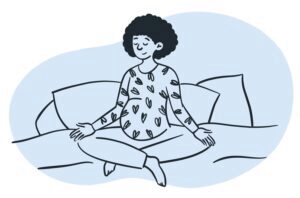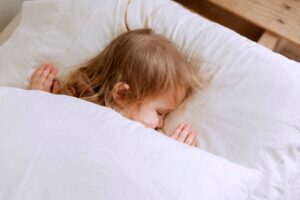Parent's Sleep Guide
Disclosure: By clicking on the product links in this article, Mattress Nerd may receive a commission fee at no cost to you, the reader. Read full disclosure statement.
Expert-Reviewed by Elizabeth King, Professional Sleep consultant at Sleep Baby Consulting.
Sleep is an important part of a baby’s development. As infants sleep, their brains grow and mature. Your little one becomes better equipped to understand language and be more attentive. Sleep also increases blood supply to the muscles, restores energy, and enables tissue growth and repair.
According to studies published in the journal of Early Human Development, babies who sleep better and longer through the night had higher cognitive scores. Additionally, with good sleep, babies were more approachable and less distractible and, not to mention, less irritable and fussy.
Getting your child on a regular nighttime and nap schedule will benefit not just your baby, but you, too. But what is considered appropriate sleep for your baby? And just how many naps should they take during the day? It all depends on their age, experts say.
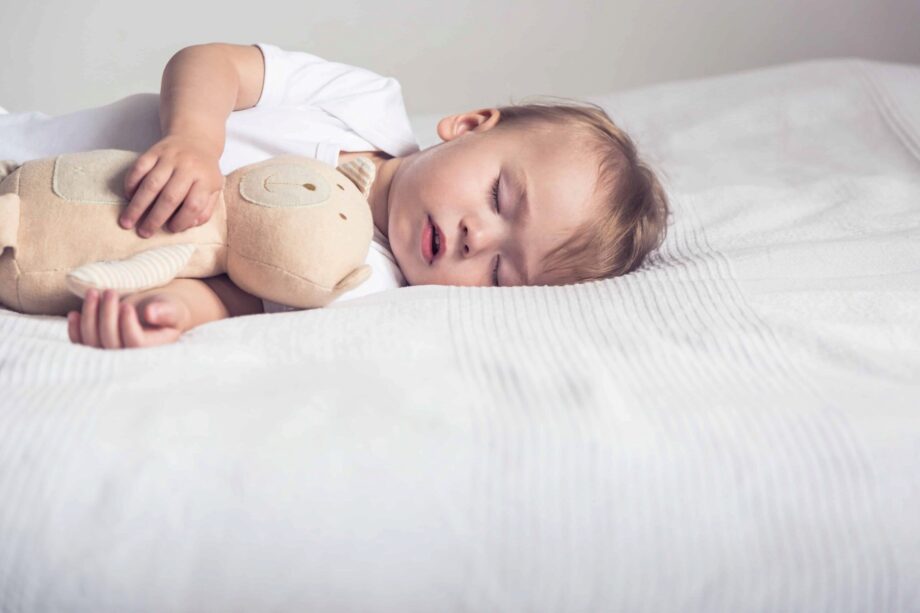
Hours of Sleep Needed by Age of Child
| Age of Child | Total Hours | Recommended Bedtime | Total Nap Hours |
| Newborn-2 Months | 16-20 hours | 9 p.m. (about 1 hour after last nap) | 7-9 hours (4-6 naps) |
| 2-4 Months | 16-18 hours | 9 p.m. (about 1-1.5 hours after last nap) | 7-9 hours (3-5 naps) |
| 4-6 Months | 12-16 hours | 6:30-8:30 p.m. (about 1-2 hours after last nap) | 4-5 hours (2-3 naps) |
| 6-12 Months | 12-16 hours | 6:00-7:30 p.m. (no more than 3.5 hours after last nap) | 4-5 hours (2-3 naps) |
| 1-2 Years | 11-14 hours | 6:30-7:30 p.m. (no more than 4 hours after last nap. Move bedtime earlier as your baby drops from 2 to 1 nap) | 2-3 hours (2 naps) |
| 3-5 Years | 10-13 hours | 6:30-8 p.m. | 0-1 hours (1 nap – naps usually stop by age 5) |
| 6-12 Years | 9-12 hours | 7:30-9 p.m. | N/A |
Newborn – 2 Months
- Hours of Sleep Required: 16-20 hours
- Recommended Bedtime: 9 p.m.
- Frequency of Naps: 4-6 naps
- Type of bed/mattress they should be using: Bassinet, cradle, or crib, preferably in parents’ room
Newborns’ sleep is disorganized. And who can blame them? They’ve literally been pushed out of the only environment they’ve ever known into a strange new world. No longer cocooned in the warmth and comfort of your womb, newborns are expected to fall peacefully asleep on their backs in a mattress with nothing around them, per the American Academy of Pediatrics (AAP) sleep guidelines.
In general, babies don’t sleep more than 4-5 hours at a time until they are at least six weeks old. Professional Sleep Consultant Elizabeth King says, “A good rule of thumb to follow is that they can sleep as many hours as they are weeks old once they’ve reached five weeks.” Newborns, in particular, need to feed frequently, about 8-12 times every 24 hours. Which means your sleep will be lacking as well. The key to ensuring good sleep as your baby gets older is to establish a good sleep routine and make sure they have a safe place to sleep.
Newborns should sleep in a bassinet, cradle, or crib that’s close to their parent’s bed, according to the AAP. The sleep surface should be firm, preferably a crib or bassinet mattress, covered with a well-fitted sheet. As tempting as it may be to fill the crib with stuffed animals and blankets, it is best to refrain for the first year because these can become safety hazards.
Bassinets and cradles are smaller beds designed for babies from birth to about four months. They usually have fixed legs while cradles generally rock or glide. These smaller beds may help premature or low-birthweight babies feel more secure. But a crib is fine for all newborns through their first few years of life.
Crib mattresses need to fit tightly into the crib so that your baby doesn’t accidentally get caught between the crib and the mattress. As a rule of thumb, you should not be able to put more than two fingers between the mattress and the side of the crib. Mattresses should also be firm, of good quality, and made of either innerspring or foam. You may also want to consider a 2-stage crib mattress, which are flippable and provide a firm mattress on one side for infants and a plusher mattress on the other side for when they grow into toddlerhood.
2 Months – 4 Months
- Hours of Sleep Required: 14-18 hours
- Recommended Bedtime: 6:30-8:30 p.m.
- Frequency of Naps: 3-4 naps
- Type of bed/mattress they should be using: Bassinet, cradle, or crib, preferably in parents’ room
By 2-3 months, your baby will likely be sleeping longer periods at night — as much as 5-6 hours, which may feel like a lifetime compared to the previous months.
By 4 months, babies should be transitioned to a crib. Most bassinets have a weight limit of about 15 to 20 pounds. As early as 4 months, your little one can begin to roll over, and their bassinet or cradle will become a safety hazard. This is the time to transition to a crib.
Babies will still spend a lot of time sleeping — as much as 14-18 hours and gradually work into a more structured nap pattern, with an earlier bedtime. According to sleep consultant Elizabeth King, “At this age, overtiredness is the biggest cause of sleep problems so don’t believe the myth that keeping your baby up will help them sleep better. For babies, sleep begets more sleep.” The AAP recommends babies continue to room-share with their parents (without bed-sharing) until at least six months. But you should visit the nursery several times a day — for diaper changes and playtime — so that the room becomes a familiar environment.
4 Months-6 Months
- Hours of Sleep Required: 14-16 hours
- Recommended Bedtime: 6:30-8:30 p.m.
- Frequency of Naps: 2-3 naps
- Type of bed/mattress they should be using: Crib, preferably in parents’ room
By 4-6 months, your baby will be getting bigger and stronger, and their circadian rhythms begin emerging, meaning they will naturally get sleepy when it gets dark outside. Naps should be becoming more regular, occurring 2-3 times daily. Bedtimes also come earlier and more structured, usually about 2-2.5 hours after their last nap.
By now, your baby should be sleeping in a crib. Again, AAP recommends room-sharing for at least the first six months of your baby’s life. However, you should continue familiarizing your baby with the nursery. During these months, babies will also begin to roll over, sit up, and reach for objects. You’ll want to be sure your baby’s crib remains free of any safety hazards, like stuffed animals, blankets, pillows, or bumpers.
6 Months-12 Months
- Hours of Sleep Required: 14-16 hours
- Recommended Bedtime: 6-7:30 p.m.
- Frequency of Naps: 2-3 naps
- Type of bed/mattress they should be using: Crib
You can now safely reclaim your bedroom and move your baby to their own room. To ease the transition, for three or four nights, you move the bedtime routine in the nursery and then bring your baby back to your room to sleep. This will help your little one learn to associate the nursery as a safe and comforting place. Some babies may wake at night because of separation anxiety. It’s OK to check on them and soothe them back to sleep.
By six months through about two years of age, your baby will begin teething. This can be uncomfortable and possibly disrupt their sleep. If teething pain becomes intense, talk to your pediatrician about whether you can give your baby an appropriate dose of infant acetaminophen or ibuprofen to help them sleep.
By the time your baby reaches their first birthday, they’ll be pulling up on their own and possibly even walking. You may wake to find your babysitting upright or standing in their crib, playing.
1-2 Years
- Hours of Sleep Required: 11-14 hours
- Recommended Bedtime: 6:30-7:30 p.m.
- Frequency of Naps: 1-2 naps
- Type of bed/mattress they should be using: Crib
Your baby will begin toddling around now and become more active. They will also gradually transition to only one nap in the afternoon. Bedtime should be moved up to no later than four hours after waking from the afternoon nap.
With your baby more alert and adventurous, it may become difficult to get your baby to sleep at night. Sleep routines continue to be very important, helping to relax your baby and prepare them for bedtime. By now, your baby can sleep in their crib with a blanket or a favorite stuffed animal, which may help them fall asleep or fall back to sleep if they wake during the night.
Your baby’s firm crib mattress is still a good sleep surface. But if you purchased a 2-stage crib mattress, you can safely flip it to the softer, toddler side.
Your baby may also start climbing out of the crib. There’s no set age when a toddler is ready to move out of their crib to a toddler or “big kid” bed. You can transition them as early as 18 months or as late as 3.5 years. Just be sure to move them before they reach your crib’s weight limit. Cribs can usually withstand up to 50 pounds. Some experts say it’s best to wait on moving babies to a toddler or “big kid” bed until they are at least 3 feet tall, which is generally about the time they turn 3.
3-5 Years
- Hours of Sleep Required: 10-13 hours
- Recommended Bedtime: 6:30-8 p.m.
- Frequency of Naps: 0-1
- Type of bed/mattress they should be using: Toddler bed or twin bed fitted with rails
The preschool years are an exciting time for your little one. Naps will become more inconsistent and some days your baby may not nap at all. You’ll need to move bedtime earlier on the days your baby skips a nap. Most babies drop their nap by age 5. When they do, they will need an extra hour of sleep at night, so be sure to adjust their bedtime accordingly if they need to be up early for preschool. Many kids potty train during this timeframe. Be prepared for nighttime accidents, which can interrupt sleep.
Your child will also outgrow their crib during this time. You can move them into a toddler bed or into a twin-size bed with rails to prevent them from rolling out of bed. Some cribs easily convert into toddler beds.
The benefit of a toddler bed is that it allows you to make longer use of your crib mattress. These beds should be equipped with side rails. Be sure to check the weight limit on your toddler bed to be sure your child doesn’t exceed the limits.
If you choose to transition your child from a crib to a twin-size bed, you’ll want a mattress designed to adapt to their growing body (as opposed to an adult’s). You’ll also want it to be durable so it can last them for several years. You may even want added features, such as water-resistant finishes to protect against nighttime accidents.
Some kids between the ages of 3 and 5 experience growing pains. It’s not believed these pains are actually caused by growing as much as it is the legs are getting used more, and get sore. Growing pains are generally felt in the thighs, calves, or behind the knees, and get worse before bedtime. They can also wake kids during the night. If your child suffers from growing pains, consider a memory foam mattress better equipped to cradle their aching muscles.
Related: Best Mattresses for Kids
6-12 Years
- Hours of Sleep Required: 9-12 hours
- Recommended Bedtime: 7:30-9 p.m.
- Frequency of Naps: N/A
- Type of bed/mattress they should be using: Twin or full-sized bed
School-aged children grow considerably during this time and are much more active. They require a lot of good sleep, typically 9-12 hours at night. You’ll want to be sure they get to bed in time to wake up feeling refreshed for school.
By now, your child should be out of a toddler bed and in either a twin-size or full-size bed. Twin and full mattresses are both 75 inches long, but a full-size mattress is 16 inches wider — 54 inches instead of 38 inches. You may want to upgrade your child to a full-size mattress as they grow older. But you’ll also want to consider the size of their room, as a larger bed will allow less room for floor play.
If your child suffers from allergies, asthma, or sensitivities, you may want to look into getting them a mattress made with organic or hypoallergenic materials. Growing pains also tend to surface in kids between 8 and 12 years of age. Contouring memory foam can help soothe these growing, aching muscles.
Related: Best Mattress for Teens
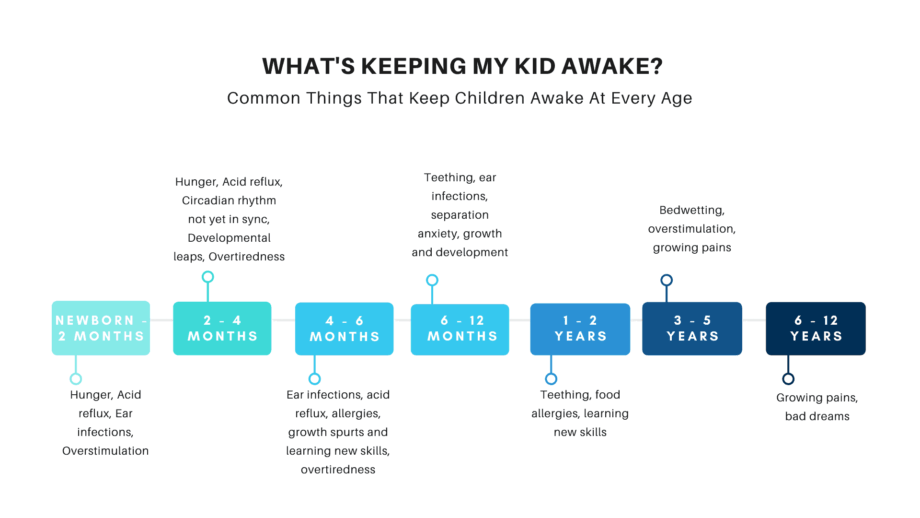
Parents, Your Sleep Matters Too
Sleep deprivation is a normal part of parenting. This is especially true during the first few weeks your baby is home because your baby needs to feed every few hours. But even as your baby grows and begins to sleep through the night, there will be times when your little one will cry out for you. Again, this is normal and should be expected, according to Alice Callahan, PhD, health and parenting expert, and author The Science of Mom: A Research-Based Guide to Your Baby’s First Year.
But when sleep deprivation becomes chronic for both baby and parents, it can be a serious problem. We know that good sleep helps babies’ bodies and minds develop healthfully. But parents need good sleep as well. Mothers of infants with sleep problems are at greater risk for postpartum depression, which can affect the care they give to their babies. Studies show that depressed mothers are more likely to report behavioral issues with their babies, such as eating problems, sleeping issues, temper tantrums, and separation anxiety.
Sleep is vital to our health and wellbeing, according to the National Heart, Lung, and Blood Institute. When we are deprived of sleep, our mental and physical health suffers. We are at greater risk for obesity, diabetes, cardiovascular disease, and early death. We are also more prone to depression, anxiety, and irritability, as well as accidents, such as car crashes and falls. However, there is hope that you and your baby can have a good night’s sleep. Some ways to promote better sleep for your baby is to start a routine.
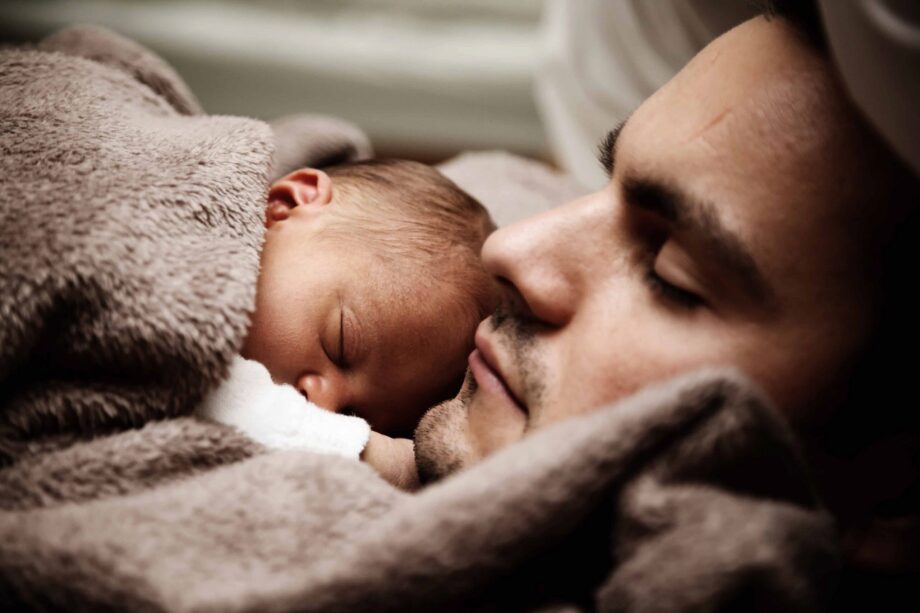
Importance of Bedtime Routines for You & Your Child
Establishing a good bedtime routine not only improves your baby’s sleep, but it can also make your night less stressful as well. According to sleep consultant Elizabeth King, “Babies as young as 8 weeks recognize a routine and what it means. An established bedtime routine can help to relax your child and cue them that it’s time to sleep.” Start your routine about 30 minutes before bedtime. Some bedtime routine activities may include:
- Dimming lights
- Giving your baby a warm bath
- Singing lullabies
- Softly reading a bedtime story
- Cuddle under a weighted blanket
When your baby is on the brink of sleep, try to lay them down in their crib so they can drift away on their own. Older kids also benefit from bedtime routines, such as turning off the TV or any stimuli 30 minutes before bedtime and reading stories together until lights out. For best results, do the same bedtime activities nightly so your child learns what to expect.
Sleep Tips for New Parents
- The American Academy of Pediatrics (AAP) discourages parents from co-sleeping, but the organization does encourage room sharing for at least the first six months.
- If you use a bassinet or cradle for your newborn, be sure to transition them to a crib by the time they reach 4 months of age. Bassinets and cradles can become safety hazards when babies begin to roll over on their own.
- Follow an age-appropriate nap schedule. A well-rested baby falls asleep and stays asleep better than an overtired one.
- Establish a bedtime routine so your baby or child learns what to expect at bedtime, and stick to it nightly for best results.
- Try to lay your baby into their crib when they become sleepy rather than after they’ve fallen asleep so they can learn to fall asleep without being held or rocked.
Conclusion
Sleep is an important part of your baby’s health and wellbeing, giving their brains and bodies time to develop and grow. Establishing a consistent bedtime routine and nap schedule will help ensure better sleep for your baby, which in turn, means better sleep for you. As a well-rested parent, you will be better equipped to give your baby the care they need.
